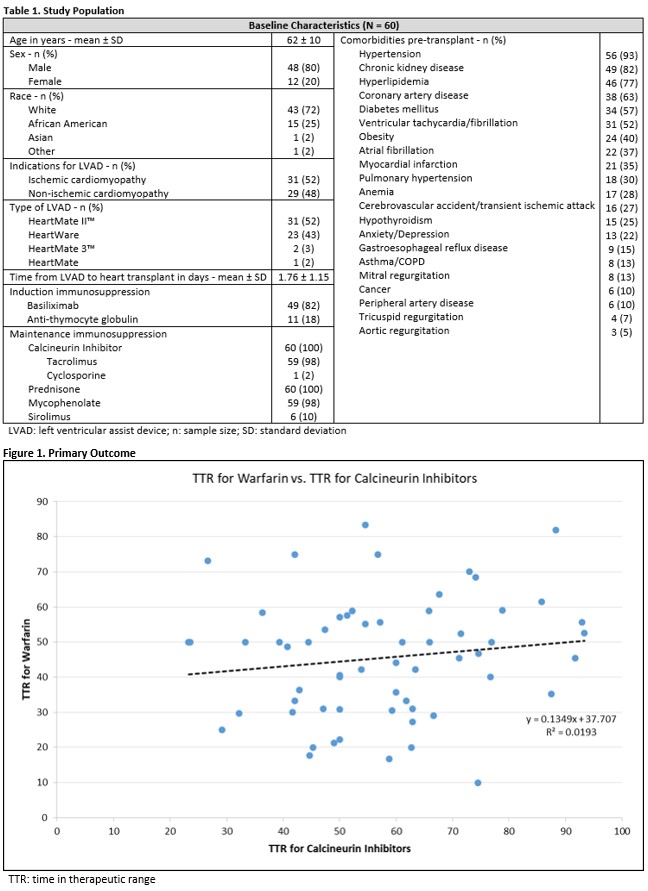Association Between Time in Therapeutic Range for Warfarin and Time in Therapeutic Range for Calcineurin Inhibitors in Patients That Received Left Ventricular Assist Devices as Bridge to Transplant
1Baylor St. Luke's Medical Center, Houston, TX, 2Baylor College of Medicine, Houston, TX
Meeting: 2022 American Transplant Congress
Abstract number: 1132
Keywords: Anticoagulation, Heart assist devices, Heart transplant patients, Immunosuppression
Topic: Clinical Science » Heart » 63 - Heart and VADs: All Topics
Session Information
Session Time: 7:00pm-8:00pm
 Presentation Time: 7:00pm-8:00pm
Presentation Time: 7:00pm-8:00pm
Location: Hynes Halls C & D
*Purpose: Medication nonadherence is a leading cause of avoidable graft failure post-transplant. The relationship between medication adherence in patients with left ventricular assist devices (LVADs) as bridge-to-transplant (BTT) and post-heart transplant immunosuppression adherence has not been assessed. This study aims to evaluate the association between the percent time in therapeutic range (TTR) for warfarin and the percent TTR for calcineurin inhibitors during the first year after heart transplant in patients that received an LVAD as BTT therapy.
*Methods: A retrospective chart review was conducted to evaluate patients 18 years of age or older who underwent heart transplant after having an LVAD as BTT and had outpatient transplant clinic follow-up visits at a quaternary academic medical center from January 2012 to September 2021. The primary analysis estimated the correlation between TTR for warfarin in patients with an LVAD as BTT and the TTR for calcineurin inhibitors within the first year after heart transplant. The association between TTR for warfarin and the TTR for calcineurin inhibitors was assessed using simple and multiple linear regressions.
*Results: Sixty patients were included, with an average of 30 INR levels and 23 calcineurin inhibitor levels evaluated per patient. The mean TTR for warfarin was 58% and the mean TTR for calcineurin inhibitors within the first year after heart transplant was 45%. The correlation between the TTR for warfarin and the TTR for calcineurin inhibitors was 0.14 (p=0.29). As depicted in Figure 1, the overall regression was not statistically significant (R2=0.02, F (1, 58)=1.14, p=0.29) after adjusting for baseline characteristics summarized in Table 1. Fifty-two patients (87%) experienced biopsy proven acute cellular rejection, of which 29% experienced grade 2R ACR, with a mean time from heart transplant to first ACR of 24 days.
*Conclusions: The correlation between TTR for warfarin while patients had an LVAD as BTT and TTR for calcineurin inhibitors within the first year after heart transplant was positive, but weak. The association was not significant even after adjusting for baseline patient and clinical characteristics, including comorbidities pre-transplant and immunosuppression induction and maintenance therapies. Prospective studies are needed to better assess the relationship between percent TTR for warfarin in patients with an LVAD as BTT and the percent TTR for calcineurin inhibitors after heart transplant.
To cite this abstract in AMA style:
Flajc G, Huang X, Minard C, Manson M, Truman Z. Association Between Time in Therapeutic Range for Warfarin and Time in Therapeutic Range for Calcineurin Inhibitors in Patients That Received Left Ventricular Assist Devices as Bridge to Transplant [abstract]. Am J Transplant. 2022; 22 (suppl 3). https://atcmeetingabstracts.com/abstract/association-between-time-in-therapeutic-range-for-warfarin-and-time-in-therapeutic-range-for-calcineurin-inhibitors-in-patients-that-received-left-ventricular-assist-devices-as-bridge-to-transplant/. Accessed December 12, 2025.« Back to 2022 American Transplant Congress

